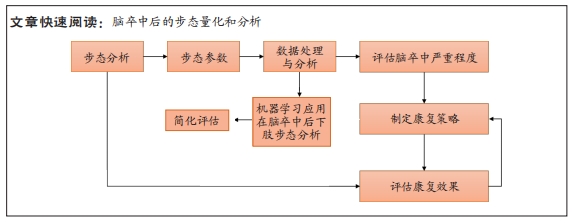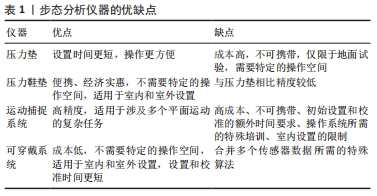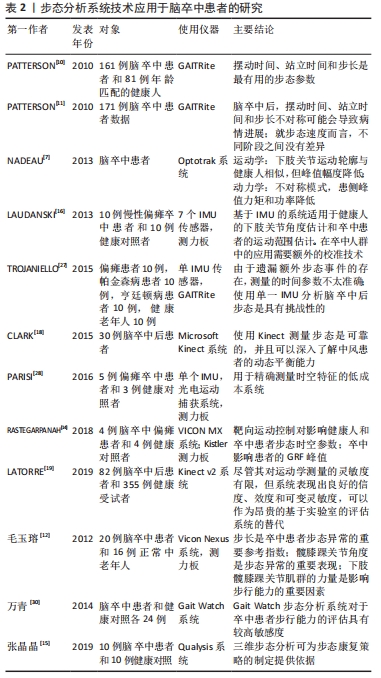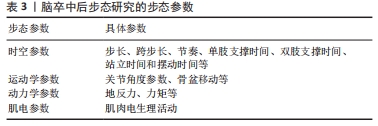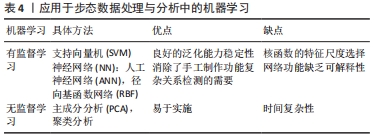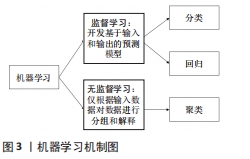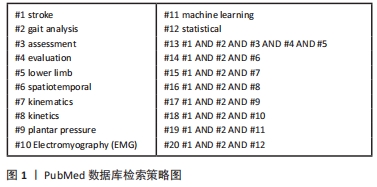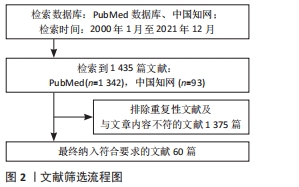[1] SOUSA RM, FERRI CP, ACOSTA D, et al. Contribution of chronic diseases to disability in elderly people in countries with low and middle incomes: a 10/66 dementia research group population-based survey. Lancet. 2009;374(9704):1821-1830.
[2] DIMYAN MA, COHEN LG. Neuroplasticity in the context of motor rehabilitation after stroke. Nat Rev Neurol. 2011;7(2):76-85.
[3] DALY JJ, NETHERY J, MCCABE JP, et al. Development and testing of the gait assessment and intervention tool (G.a.I.T.): a measure of coordinated gait components. J Neurosci Methods. 2009;178(2):334-339.
[4] TORO B, NESTER C, FARREN P. Review of observational gait assessment in clinical practice. Physiother Prac. 2002;19(3):137-149.
[5] FRANCESCO F, MARIA B, MARCO B, et al. Tools for observational gait analysis in patients with stroke: a systematic review. Phys Ther. 2013;93(12):1673-1685.
[6] TURANI N, LU AEK, KARATAÅ M, et al. Assessment of hemiplegic gait using the wisconsin gait scale. Scand J Caring Sci. 2004;18(1):103-108.
[7] NADEAU S, BETSCHART M, BETHOUX F. Gait analysis for poststroke rehabilitation: the relevance of biomechanical analysis and the impact of gait speed. Phys Med Rehabil Clin N Am. 2013;24(2):265-276.
[8] MURO-DE-LA-HERRAN A, GARCÍA-ZAPIRAIN B, MÉNDEZ-ZORRILLA A. Gait analysis methods: an overview of wearable and non-wearable systems, highlighting clinical applications. Sensors (Basel). 2014;14(2):3362-3394.
[9] MUNDERMANN L, CORAZZA S, ANDRIACCHI TP. The evolution of methods for the capture of human movement leading to markerless motion capture for biomechanical applications. J Neuroeng Rehabil. 2006;3:6.
[10] PATTERSON KK, GAGE WH, BROOKS D, et al. Evaluation of gait symmetry after stroke: a comparison of current methods and recommendations for standardization. Gait Posture. 2010;31(2):241-246.
[11] PATTERSON KK, GAGE WH, BROOKS D, et al. Changes in gait symmetry and velocity after stroke: a cross-sectional study from weeks to years after stroke. Neurorehabil Neural Repair. 2010;24(9):783-790.
[12] 毛玉瑢,李乐,陈正宏,等.脑卒中患者步行能力与下肢三维运动学及动力学相关性分析[J].中国康复医学杂志,2012,27(5):442-447.
[13] RAZAK AH, ZAYEGH A, BEGG RK, et al. Foot plantar pressure measurement system: a review. Sensors (Basel). 2012;12(7):9884-9912.
[14] RASTEGARPANAH A, SCONE T, SAADAT M, et al. Targeting effect on gait parameters in healthy individuals and post-stroke hemiparetic individuals. J Rehabil Assist Technol Eng. 2018;5:2055668318766710.
[15] 张晶晶,李艳.脑卒中偏瘫步态特点及康复策略[J].中国老年学杂志,2019, 39(5):1044-1047.
[16] LAUDANSKI A, BROUWER B, LI Q. Measurement of lower limb joint kinematics using inertial sensors during stair ascent and descent in healthy older adults and stroke survivors. J Healthc Eng. 2013;4(4):555-576.
[17] SZCZERBIK E, KALINOWSKA M. The influence of knee marker placement error on evaluation of gait kinematic parameters. Acta Bioeng Biomech. 2011;13(3):43-46.
[18] CLARK RA, VERNON S, MENTIPLAY BF, et al. Instrumenting gait assessment using the kinect in people living with stroke: reliability and association with balance tests. J Neuroeng Rehabil. 2015;12:15.
[19] LATORRE J, COLOMER C, ALCAIZ M, et al. Gait Analysis with the Kinect V2: normative study with healthy individuals and comprehensive study of its sensitivity, validity, and reliability in individuals with stroke. J Neuroeng Rehabil. 2019;16(1):97.
[20] MÜNDERMANN L, CORAZZA S, ANDRIACCHI TP. The Evolution of methods for the capture of human movement leading to markerless motion capture for biomechanical applications. J Neuroeng Rehabil. 2006;3:6.
[21] KNIPPENBERG E, VERBRUGGHE J. Markerless motion capture systems as training device in neurological rehabilitation: a systematic review of their use, application, target population and efficacy. J Neuroeng Rehabil. 2017;14(1):61.
[22] LI M, TIAN S, SUN L, et al. Gait Analysis for post-stroke hemiparetic patient by multi-features fusion method. Sensors (Basel). 2019;19(7):1737.
[23] BERGAMINI, ELENA, LIGORIO, et al. Estimating orientation using magnetic and inertial sensors and different sensor fusion approaches: accuracy assessment in manual and locomotion tasks. Sensors (Basel). 2014;14(10):18625-18649.
[24] CHE-CHANG Y, YEH-LIANG H. A review of accelerometry-based wearable motion detectors for physical activity monitoring. Sensors (Basel). 2010;10(8):7772-7788.
[25] SANG V, YANO S, KONDO T. On-body sensor positions hierarchical classification. Sensors (Basel). 2018;18(11):3612.
[26] VALENTINA C, ELENA B, SILVIA F, et al. Trends supporting the in-field use of wearable inertial sensors for sport performance evaluation: a systematic review. Sensors (Basel). 2018;18(3):873.
[27] TROJANIELLO D, RAVASCHIO A, HAUSDORFF JM, et al. Comparative assessment of different methods for the estimation of gait temporal parameters using a single inertial sensor: application to elderly, post-stroke, parkinson’s disease and huntington’s disease subjects. Gait Posture. 2015;42(3):310-316.
[28] PARISI F, FERRARI G, BARICICH A, et al. Accurate Gait Analysis in Post-Stroke Patients Using a Single Inertial Measurement Unit: 2016 IEEE 13th International Conference on Wearable and Implantable Body Sensor Networks (BSN), 2016.
[29] AQUEVEQUE P, ORTEGA P, PINO E, et al. After Stroke Movement Impairments: A Review of Current Technologies for Rehabilitation. Physical Disabilities - Therapeutic Implications, 2017.
[30] 万青,吴伟,刘慧华,等.脑卒中患者偏瘫步态的时空及关节运动学参数分析[J].中国康复医学杂志,2014,29(11):1026-1030.
[31] 王桂茂,严隽陶,刘玉超,等.脑卒中偏瘫步态的时空参数与骨盆运动学分析[J].中国康复医学杂志,2010,25(12):1148-1151.
[32] ZUKOWSKI LA, FELD JA, GIULIANI CA, et al. Relationships between gait variability and ambulatory activity post stroke. Top Stroke Rehabil. 2019;26(4):255-260.
[33] LEWEK MD, BRADLEY CE, WUTZKE CJ, et al. The relationship between spatiotemporal gait asymmetry and balance in individuals with chronic stroke. J Appl Biomech. 2014;30(1):31-36.
[34] HENDRICKSON J, PATTERSON KK, INNESS EL, et al. Relationship between asymmetry of quiet standing balance control and walking post-stroke. Gait Posture. 2014;39(1):177-181.
[35] 杜玲玲,夏清.脑卒中偏瘫患者膝过伸步态运动学特点分析[J].中国康复, 2018,33(1):7-10.
[36] DE QUERVAIN IA, SIMON SR, LEURGANS S, et al. Gait pattern in the early recovery period after stroke. J Bone Joint Surg Am. 1996;78(10):1506-1514.
[37] WONSETLER EC, BOWDEN MG. A systematic review of mechanisms of gait speed change post-stroke. part 2: exercise capacity, muscle activation, kinetics, and kinematics. Top Stroke Rehabil. 2017;24(5):394-403.
[38] 徐光青,黄东锋,兰月,等.脑卒中患者下肢关节运动对步行能力影响的三维运动学研究[J].中国临床康复,2004,8(31):6816-6818.
[39] JONKERS I, DELP S, PATTEN C. Capacity to increase walking speed is limited by impaired hip and ankle power generation in lower functioning persons post-stroke. Gait Posture. 2009;29(1):129-137.
[40] WILLIAMS G, MORRIS ME, SCHACHE A, et al. People preferentially increase hip joint power generation to walk faster following traumatic brain injury. Neurorehabil Neural Repair. 2010;24(6):550-558.
[41] TITIANOVA EB, MATEEV PS, PEURALA SH, et al. Footprint peak time and functional ambulation profile reflect the potential for hemiparetic gait recovery. Brain Inj. 2005;19(8):623-631.
[42] RUSU L, PAUN E, MARIN MI, et al. Plantar pressure and contact area measurement of foot abnormalities in stroke rehabilitation. Brain Sci. 2021;11(9):1213.
[43] PERRY J, BURNFIELD JM. Gait Analysis: Normal and Pathological Function. Gait Analysis: Normal and Pathological Function, 2010.
[44] RAJA B, NEPTUNE RR, KAUTZ SA. Coordination of the non-paretic leg during hemiparetic gait: expected and novel compensatory patterns. Clin Biomech (Bristol, Avon). 2012;27(10):1023-1030.
[45] OTTER ARD, GEURTS ACH, MULDER T, et al. Abnormalities in the temporal patterning of lower extremity muscle activity in hemiparetic gait. Gait Posture. 2007;25(3):342-352.
[46] LIN PY, YANG YR, CHENG SJ, et al. The relation between ankle impairments and gait velocity and symmetry in people with stroke. Arch Phys Med Rehabil. 2006;87(4):562-568.
[47] CRUZ TH, LEWEK MD, DHAHER YY. Biomechanical impairments and gait adaptations post-stroke: multi-factorial associations. J Biomech. 2009;42(11): 1673-1677.
[48] ROCHE N, BONNYAUD C, GEIGER M, et al. Relationship between hip flexion and ankle dorsiflexion during swing phase in chronic stroke patients. Clin Biomech (Bristol, Avon). 2015;30(3):219-225.
[49] WIKSTR M J, GEORGOULAS G, MOUTSOPOULOS T, et al. Intelligent data analysis of instrumented gait data in stroke patients-a systematic review. Comput Biol Med. 2014;51:61-72.
[50] ENI H, APOORVA R, MADALINA F, et al. Machine learning in human movement biomechanics: best practices, common pitfalls, and new opportunities. J Biomech. 2018;81:1-11.
[51] OLNEY SJ, GRIFFIN MP, MCBRIDE ID. Multivariate examination of data from gait analysis of persons with stroke. Phys Ther. 1998;78(8):814-828.
[52] MILOVANOVI I, POPOVI DB. Principal component analysis of gait kinematics data in acute and chronic stroke patients. Comput Math Methods Med. 2012; 2012:649743.
[53] BOUDARHAM J, ROCHE N, PRADON D, et al. Variations in kinematics during clinical gait analysis in stroke patients. PLoS One. 2013;8(6):e66421.
[54] LAU HY, TONG KY, ZHU H. Support vector machine for classification of walking conditions of persons after stroke with dropped foot. Hum Mov Sci. 2009;28(4): 504-514.
[55] WANG FC, CHEN SF, LIN CH, et al. Detection and classification of stroke gaits by deep neural networks employing inertial measurement units. Sensors (Basel). 2021;21(5):1864.
[56] MULROY S, GRONLEY JA, WEISS W, et al. Use of cluster analysis for gait pattern classification of patients in the early and late recovery phases following stroke. Gait Posture. 2003;18(1):114-125.
[57] KIKKERT LHJ, GROOT MHD, CAMPEN JPV, et al. Gait dynamics to optimize fall risk assessment in geriatric patients admitted to an outpatient diagnostic clinic. PLoS One. 2017;12(6):e0178615.
[58] PUNT M, BRUIJN SM. Characteristics of daily life gait in fall and non fall-prone stroke survivors and controls. J Neuroeng Rehabil. 2016;13(1):67.
[59] WEI TS, LIU PT, CHAGN LW, et al. Gait asymmetry, ankle spasticity, and depression as independent predictors of falls in ambulatory stroke patients. PLoS One. 2017;12(5):e0177136.
[60] O’REILLY C, PLAMONDON R, LEBRUN LH. Linking brain stroke risk factors to human movement features for the development of preventive tools. Front Aging Neurosci. 2014;6:150.
|
